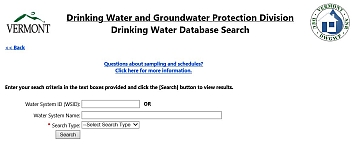A seasonal public water system is a transient non-community water system that is not operated as a public water system on a year-round basis and starts up and shuts down at the beginning and end of each operating season. Seasonal systems:
- Do not serve water to a public population (25 or more people) year round;
- Start-up and shutdown at the beginning and end of an operating system; and
- Seasonal systems do not necessarily depressurize.
Examples of typical seasonal TNC water systems:
- Campgrounds
- Country Clubs
- Golf Courses
- Marinas
- Parks (Town, State, and Federal)
- Picnic Areas
- Recreation Centers
- Ski Resorts
- Summer Camps
Monthly Monitoring for Total Coliform Bacteria
Under the Revised Total Coliform Rule, seasonal systems are required to monitor monthly for total coliform bacteria during the months that the facility is open to the public. The operating dates of a water system have been determined through sanitary surveys, operating period survey forms, and correspondence with a water system's contacts. The operating dates are reported on the Monitoring Schedule and Annual Report. Hardcopies of the Monitoring Schedules are mailed to all water systems annually; the DWGWPD also provides real-time, up-to-date monitoring schedules on its website through the Monitoring Schedule Tool. If your water system does not start-up or shutdown in the months indicated on the Monitoring Schedule please contact a member of the TNC Program.
System Start-Up and Shutdown
A lot can happen in the off-season; the process of starting up and shutting down a seasonal system presents additional opportunities for contamination to enter or spread through the distribution system. For this reason, all seasonal water systems must complete a Seasonal Start-Up Procedure and Certification Form to certify that they have verified the sanitary condition of the system before water is served to the public. A hardcopy of the Seasonal Start-Up Procedure and Certification form is mailed to seasonal systems annually with their monitoring schedules. Completed and signed Seasonal Start-Up Procedure and Certification forms must be submitted to the DWGWPD no later than 10 days following the month of service start-up. Failure to complete the procedures and submit the form will result in a Treatment Technique and/or Reporting Violation.
Seasonal Start-Up Procedure and Certification Guidance:
The purpose of the Seasonal Start-Up Procedure and Certification form is to identify and eliminate pathways of contamination prior to serving water to the public. This form is intended to look identify pathways of contamination that may result in the presence of bacteria or waterborne pathogens. Follow the directions on the Seasonal Start-Up Procedure. The form will walk through the components of your water system to ensure they are maintained, operating properly, and are in a sanitary condition prior to opening the business. The goal of the form is to eliminate pathways of contamination that develop during the off-season and to ensure clean water is being serving to the public upon start-up.
Step 1: Obtain a copy of the Seasonal Start-Up Procedures and Certification form based on your water source type:
- Surface Water and GWUDI Systems - Seasonal Start-Up Procedures and Certification
- Groundwater Systems - Seasonal Start-Up Procedures and Certification
Step 2: Conduct a visual inspection of the water system that includes the source, treatment facilities, storage facilities, distribution system, and sample locations.
Step 3: Describe the procedure you use to start-up your seasonal water system. This may include shock-chlorinating the source and storage tanks or a line flushing procedure. Guidance documents are provided by the Vermont Department of Health and Vermont Rural Water Association.
Step 4: Collect your monthly Routine sample anytime during the month that you will open.
Step 5: Sign the Certification of Completion.
Step 6: Submit the form to the DWGWPD no later than 10 days following the month of service start-up (e.g. the report is due by June 10th for systems returned to service in May). Keep a copy of your form for your records.


